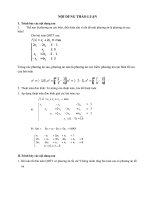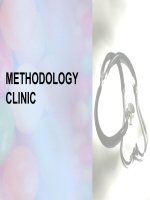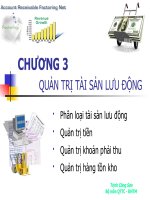Nội quy thảo luận "DDKT - Vietnam"
Bạn đang xem bản rút gọn của tài liệu. Xem và tải ngay bản đầy đủ của tài liệu tại đây (2.15 MB, 31 trang )
Northern Territory Tourist Commission
MARKETING PLAN
2003 - 2005
2
3
NT TOURIST COMMISSION
MARKETING PLAN
CONTENTS
The Plan 5
Market Overview 6
Challenges and Opportunities 8
Destination Marketing 9
Sectoral Marketing 9
Competitive Environment 10
Target Markets 12
Domestic Market 12
Market Segmentation 13
International Markets 14
Targets 16
Marketing Priorities 18
The Campaign 19
Cooperative Marketing 20
Marketing Strategies 21
The Team 21
Brand Position 22
Destination Development 23
Distribution and Conversion 24
Partnerships 26
Measurements of Success 27
4
5
THE PLAN
This Marketing Plan is based on the Northern Territory
Tourism Strategic Plan 2003-2007. The Strategic Plan was
launched in November 2003, following extensive
consultation with industry. The Strategic Plan provides a
framework and clear direction for a sustainable tourism
industry in the Northern Territory for future generations of
visitors and residents.
The Northern Territory Tourist Commission (NTTC)
facilitated the process of developing the Strategic Plan. The
NTTC has an ongoing commitment to implement the
strategies in the Strategic Plan over a period of five-years,
in partnership with industry and government.
Like its industry partners, the NTTC continually reviews
and, if necessary, adapts to the political, economic, social
and technological changes in the marketplace. One of the
most recent changes includes the substantial increase in
Northern Territory (NT) Government funding made
available to the NTTC. An additional $27.5 million was
allocated, to be expended in 2003/04 to 2005/06. This
Plan includes details of activity resulting from the additional
funding, particularly relating to destination and sector-
specific marketing.
The development of a Marketing Plan reflects the annual
review of market conditions, and enables the local industry,
Regional Tourism Associations (RTAs) in the NT and allied
industry partners to better understand and associate with
the marketing activities of the NTTC. This promotes
increased alignment of their activities with those of the
NTTC for maximum benefit and return on investment.
The Plan should be read in conjunction with the 2003-04
Partnership Marketing Guide, which provides more specific
detail about the full range of cooperative engagement
opportunities that exist between tourism operators, the
NTTC and other agencies of government.
The 2003-04 Marketing Plan will greatly improve
communication and cooperation between the NTTC and
industry partners. It provides an overview of the market,
identifies the challenges and marketing priorities and sets
out the marketing direction of the NTTC during the next
12 months.
6
MARKET OVERVIEW
A SNAPSHOT
In 2002/03, the estimated direct expenditure of visitors to and within the
NT was $1.07 billion. This expenditure provides 14,200 jobs for people in
the NT. Tourism is the second largest industry in the Territory, directly
accounting for 4.9% of the NT’s overall Gross State Product and
employing more people than any other industry.
Total visitor numbers to the NT have remained relatively static between
1995/96 and the present, with 1.699 million in 2002/03. Holiday visitors
accounted for 61% of all visitors, followed by visiting friends and relatives
(VFR) at 16% and business related travel at 14%.
Traditionally, destinations have measured success using total visitor
numbers. This measurement is unlikely to be sustainable in the long term.
This is because it will place increasing pressure on the natural and cultural
assets of the NT, and because it fails to address important issues of regional
and seasonal dispersal. These, and other issues, will underpin the long-
term sustainability and profitability of the tourist industry in the NT.
As indicated in the Northern Territory Tourism Strategic Plan 2003-2007,
as the chief NT tourism marketing agency, the NTTC will focus on
attracting tourists who stay longer, spend more, travel more widely and
have a propensity to travel outside traditional peak periods.
The NTTC’s primary focus will therefore be on attracting holiday and
business tourism (convention, meeting, incentives and event) visitors, who
together represent the largest proportion of visitors to the NT. These
visitors are people the NTTC, together with the tourism industry, can most
readily influence.
Purpose of visit to the NT
Source: NT Travel Monitor, 2002/03
Not stated
1%
Other
8%
Business
14%
Visit friends
and relatives
16%
Holiday/
pleasure
61%
7
Intra-territory
256,000
25%
Interstate
360,000
35%
International
416,000
40%
Interstate
2,435,000
52%
International
1,481,000
32%
Intra-territory
$39.7M
6%
Interstate
$315.7M
48%
International
$305.8M
46%
Intra-territory
737,000
16%
The NT Holiday Market 2002/03
Visitor Numbers Visitor Nights Visitor Expenditure
Source: NT Travel Monitor, 2002/03
In 2002/03 the international market accounted for 40% of holiday visitors
to the NT. This figure declined from 44% in 2001/02. The interstate
market accounted for 35% of holiday visitors to the NT in 02/03 but
accounted for 52% of nights stayed by visitors and 48% of visitor
expenditure.
Prior to and following the events of September 11 2001, there have been
many other impacts, on consumer confidence and the tourism industry in
the NT, particularly on international visitation. These impacts include the
East Timor crisis in 1999/2000, the demise of Ansett Airlines, the Bali
bombing in 2002, the outbreak of SARS with the resulting cancellation of
the 2003 Arafura Games, the Iraq war and the decline in international
airline access and connectivity.
In spite of these events, there have been some positive developments in
the NT to provide cause for a cautiously optimistic outlook. These include
the opening of the Alice Springs Convention Centre in 2002, the entry and
expansion of Virgin Blue services into the NT, the commencement of the
extended Ghan passenger rail service to Darwin in February 2004 and the
introduction of an Australian Airlines service from Singapore to Darwin.
Additionally, the NT Government has recently announced the $600m
development of the Darwin Waterfront Precinct, featuring a purpose-built
convention centre, due to open in 2006. There is also pleasing evidence of
the resilience and growth of the domestic drive-market during the past
year.
Holiday Visitors
Visitors Nights Length of Daily Av. Expenditure
(000s) (000s) Stay (Days) Spend ($) ($M)
Intra-territory 513 1909 3.7 63 120.0
NSW / ACT 105 677 6.4 149 100.6
VIC / TAS 117 724 6.2 148 107.4
QLD 57 407 7.1 120 48.7
SA 45 357 7.9 81 28.9
WA 35 271 7.7 111 30.1
Total Interstate 360 2435 6.8 130 315.7
UK/Ire/Scand 124 563 4.5 187 105.3
Europe (excl. Germany) 76 254 3.3 231 58.8
Germany 49 197 4.0 176 34.7
North America 75 191 2.5 259 49.4
New Zealand 21 113 5.4 115 13.0
Japan 52 85 1.6 340 28.9
Asia (excl. Japan) 4 21 5.3 262 5.5
Total International 416 1,481 3.6 206 305.8
8
CHALLENGES AND OPPORTUNITES
Many of the marketing and communications challenges facing the NT
tourism industry in general and the NTTC in particular are not necessarily
new, but have been amplified of late because of external influences
discussed on the previous page. These challenges include: overcoming the
limitations of international airline access and connectivity, especially from
Europe and the UK; building shoulder season demand; increasing the
range and diversity of distributed NT product; and competing in a highly
competitive domestic market.
In identifying the NT’s building blocks and opportunities for the future, the
NTTC has singled out nature-based and cultural tourism experiences.
Research has shown these are primary motivators to visit the NT, and have
the greatest long-term potential for growth. It is therefore crucial to
recognise the positive influence of tourism in conserving and interpreting
the unique cultural and natural values of the NT.
NTTC marketing activity will support the ‘destination’ approach to tourism
development as an alternative to the ‘regional’ approach which, in the
past, has based consumer communications upon artificial regional
boundaries. The destination marketing approach will seek to develop new
destinations in line with consumer demand and travel behaviour, thereby
adding depth and diversity to the attraction of established NT iconic
regions.
This will not be pursued at the exclusion or diminution of the profile of NT
icons from NTTC marketing communications.
Nature-based Tourism
Nature-based experiences are strongly associated with the NT and are the
backbone of tourism in the region. In order for nature-based tourism to
remain viable, marketing strategies of the NTTC, along with plans of other
parties including Traditional Owners, land users and conservation groups,
must be compatible and guided by three key principles:
• Development must be sustainable.
• Experiences must be interpretive.
• The integrity of the destination must be maintained.
Cultural Tourism
The NT is strongly associated with indigenous tourism experiences.
Continuing to develop and promote the number and quality of experiences
and interpretation is crucial to the continued growth and long-term
sustainability of tourism in the Territory. These experiences and the way in
which they are marketed must be sensitive to indigenous culture.
Participation by indigenous communities is essential to the success of these
products.
The Marketing Plan also recognises the potential to improve the
interpretation and communication of the heritage and historical values of
the NT. These range from the indigenous culture to the pioneering history
and incorporate WWII sites and the bombing of Darwin.
9
DESTINATION MARKETING
As a direct result of the additional funding allocation, the NTTC will
establish a Destination Marketing Unit. The unit will work with the RTAs
and local industry representatives on the development of regional
campaigns that link with and support the domestic marketing direction of
the NTTC.
Initially, regional marketing communication activities will be developed for
Katherine, Alice Springs and Darwin. The NTTC has already commenced
working in partnership with other agencies and organisations (including
the Office of Territory Development, the Darwin City Council, Tourism Top
End and Charles Darwin University) in repositioning Darwin as a significant
growth centre and capital city with outstanding employment, education
and investment opportunities.
The NTTC will incorporate unique, regularly-occuring Territory festivals
and events in its marketing communications. These include the Camel Cup,
the Finke Desert Race, Masters Games, Henley-on-Todd Regatta, the
Garma Festival, Darwin Cup and the Aboriginal and Torres Strait Islander
Art Awards. Together with other high-profile sporting fixtures, including
V8 Super Car Championship series, test match and one-day international
cricket, AFL pre-season and home-and-away matches and NBL basketball
contests, events will be used in direct and relationship marketing activity to
give people more reasons to visit the NT.
SEGMENT MARKETING
In addition to specific domestic and international marketing activities
described in the following pages, the NTTC has strategies in place to
address the business tourism, drive, fishing and unstructured backpacker
market sectors. These strategies apply to both the domestic and
international markets.
Another marketing initiative is designed to draw attention to some of the
more up-market, unique, remote, distinctively NT and indigenous tourism
experiences that uphold the brand promise of “it’ll never never leave you”,
is also planned. It is anticipated that this “five-star experiences” concept
will appeal to the Affluent Adventure domestic target market segment (see
page 13).
Many of the strategies to target these market sectors will be of a direct
marketing nature and/or involve forms of non-traditional distribution. The
NTTC is therefore placing a high importance on the development of its
customer relationship marketing (CRM) capability. This will enable the
NTTC to capture and use prospect data in campaign activity with
measurable conversion outcomes.
10
COMPETITIVE ENVIRONMENT
There is an ever-present convergence of marketing strategies between
State and Territory Tourism Organisations (STOs) in Australia, with
competing destinations. All adopt similar strategies and target the same
market segments. A summation of the current tourism communications
environment is as follows:
STATE/TERRITORY/ORGN. Top of Mind Images ADVERTISING PROMISE
Australian Capital Territory Parliament House, Another face of our
National Galleries and national capital
Museums, War
Memorial, Floriade
New South Wales Sydney Opera House, Feel Free New South
The Bridge, The Rocks, Wales
shopping, Blue
Mountains
Northern Territory Ayers Rock, Alice Springs, It’ll never never leave
the Outback, wildlife, you
Aboriginal art and culture,
Kakadu, The Ghan
Queensland Barrier Reef, Gold Coast, Where else but
Theme Parks, Islands, Queensland
Tropical rainforest
See Australia Outback, Big Cities, Go on. Get out there.
Wineries, water-based
activities
South Australia Adelaide, wineries, food, Discover the Secrets of
Kangaroo Island, heritage South Australia
and the Arts, Flinders
Ranges, events
Tasmania Heritage, Port Arthur, Rejuvenating Journey
Franklin River, nature,
accessibility
Victoria Melbourne, football, You’ll love every piece of
Grampians, food and Victoria
wine, shopping, arts and
heritage, Grand Prix,
sophistication
Western Australia Perth, Swan River, Be touched by nature
Kimberley and The
Outback, Fremantle,
Broome, dolphins,
Kalgoorlie, nature
This “sea of sameness” demands a different approach to both the way
that the NT is positioned and the method of communicating to existing
and potential consumers. Our competitors have also had larger marketing
budgets (see media expenditure comparison - opposite page), a greater
critical mass of well-established tourism businesses and are closer to the
major source markets.
The NT has a perceived competitive advantage in terms of “big nature”,
featuring the iconic national parks of Uluru-Kata Tjuta, Watarrka (Kings
Canyon), Kakadu and Nitmiluk (Katherine Gorge), plus the emergence of
Litchfield, in close proximity to Darwin. Indigenous art and culture,
together with the quintessential Australian outback are also synonymous
with the NT, particularly in the international markets.









